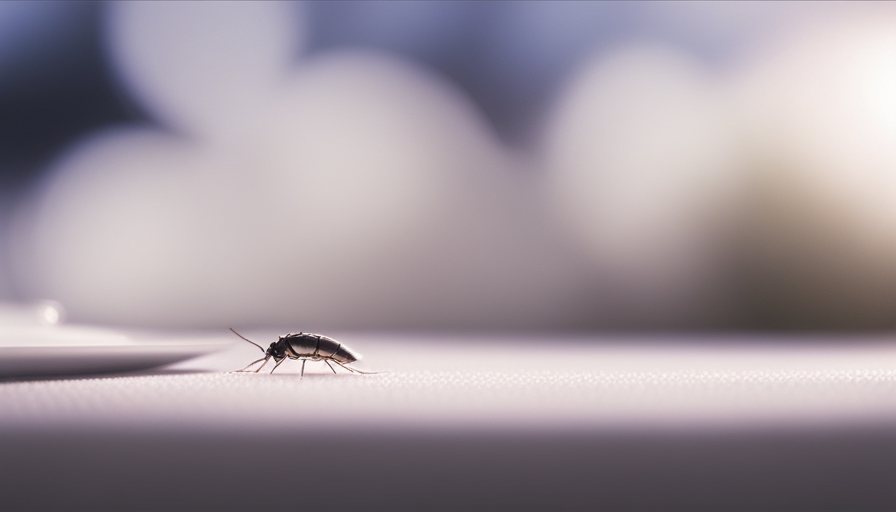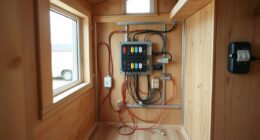Have you ever stepped into your home only to find yourself welcomed by a horde of small grey insects darting over your floors and walls? I certainly have, and I must say, it’s not a welcoming view. These tiny, elusive pests can be a real headache, stirring up irritation and worry for homeowners such as myself.
Take, for example, the case of Sarah, a young woman who recently moved into a new apartment. Within days of settling in, she noticed these minuscule grey bugs crawling in her kitchen and bathroom. They seemed to be multiplying rapidly, appearing in every nook and cranny. Sarah’s initial curiosity quickly turned into concern as she wondered what these pests were and how to get rid of them.
If you find yourself in a similar situation, fear not! In this article, I will provide you with valuable information on these tiny grey bugs, including how to identify them, the common types you may encounter, the causes of infestation, prevention tips, natural remedies, chemical solutions, and more. By the end of this article, you’ll have all the knowledge you need to tackle these pesky intruders and reclaim a bug-free home.
Key Takeaways
- Tiny grey bugs found in houses include silverfish, carpet beetles, psocids (booklice), and springtails.
- These bugs thrive in damp and dark environments, such as basements and bathrooms.
- Severe infestations can be identified by shed exoskeletons, yellow stains on fabric or paper, and small holes in clothing or books.
- To prevent and eliminate these bugs, it is important to eliminate food sources, use insecticides or traps, and address excess moisture in the home.
Identify the Bugs
Have you ever wondered what those tiny grey bugs in your house are? Well, you’re not alone. These pesky creatures are commonly known as silverfish.
Silverfish are small, wingless insects that are typically about half an inch long and have a silver-gray color. They are nocturnal creatures that thrive in damp, dark environments such as basements and bathrooms.
To get rid of silverfish, there are several treatment options available. First, you can try eliminating their food sources by properly storing food and removing any excess moisture in your home. Additionally, using insecticides or traps specifically designed for silverfish can help control their population.
If you notice a severe infestation of silverfish, there are a few signs to look out for. These include finding shed exoskeletons, yellow stains on fabric or paper, and small holes in clothing or books. If you spot these signs, it may be necessary to seek professional pest control assistance.
Moving on to the next section, let’s explore the common types of tiny grey bugs that can invade your home.
Common Types of Tiny Grey Bugs
In my exploration of common types of tiny grey bugs, I’ve come across four noteworthy ones: silverfish, carpet beetles, psocids (also known as booklice), and springtails.
Silverfish, with their elongated bodies and silvery scales, are often found in dark and damp areas of the house, feeding on starchy materials like paper and glue.
Carpet beetles, on the other hand, have a small, round shape and can cause damage to carpets, fabrics, and even stored food items.
Psocids, resembling miniature insects with soft bodies and long antennae, are commonly found in books and damp areas, and can be a nuisance to homeowners.
Lastly, springtails are tiny, wingless insects that have the ability to jump long distances, making them difficult to catch.
These four types of tiny grey bugs vary in appearance and habits, but all have the potential to invade and disrupt the peace of your home.
Silverfish
Spotting tiny grey bugs in your house? Well, you might just have a silverfish problem!
Silverfish are small, wingless insects that are typically gray or silver in color. They have a unique appearance, with a carrot-shaped body and long antennae. These pests are known for their destructive feeding habits, as they consume a variety of materials such as paper, glue, and clothing.
Signs of a silverfish infestation include finding small holes in paper or fabric, yellowish stains on clothing, and seeing their excrement, which resembles tiny black pepper flakes.
If you’re looking for natural ways to repel silverfish, there are a few options. First, you can try using essential oils like lavender, cedar, or citrus, as these scents are known to repel silverfish. Additionally, ensuring your home is free of excess moisture by using dehumidifiers or fixing leaks can help deter these pests, as they are attracted to damp environments.
Now, let’s move on to the next topic: carpet beetles.
Carpet Beetles
If you’re dealing with a carpet beetle infestation, don’t worry, there are effective methods to eliminate and prevent them from returning.
Carpet beetles are small, oval-shaped insects that can cause damage to fabrics, carpets, and other household items. They can be found in dark, undisturbed areas such as closets, attics, and basements.
To deter carpet beetles naturally, you can use essential oils like lavender or cedar, as these scents are known to repel them. Additionally, keeping your home clean and vacuuming regularly can help prevent infestations.
Signs of carpet beetle damage in the house include small holes in fabrics, larvae casings, and shed skins. By taking these preventative measures, you can protect your home from carpet beetles and minimize the risk of damage.
Moving on to psocids (booklice), these tiny insects…
Psocids (Booklice)
To get rid of psocids (booklice), you can try using a dehumidifier to reduce the moisture in your home, which these pesky insects thrive on.
Psocids are tiny, pale grey insects that are commonly found in homes. They are attracted to areas with high humidity levels, such as bathrooms, kitchens, and basements. To prevent psocids from infesting your home, it is important to keep your living space dry and well-ventilated.
Signs of a psocid infestation include the presence of these small bugs on books, papers, or damp areas of your home. If you notice any signs of psocids, it’s important to take immediate action to prevent further infestation.
Now, let’s move on to the next section about springtails.
Springtails
After learning about Psocids (Booklice), it’s time to delve into another common tiny grey bug that can be found in houses: Springtails.
Springtails are small, wingless insects that belong to the order Collembola. They are named for their ability to jump using a unique structure called a furcula, which is like a springboard on their abdomen. This allows them to move quickly and escape from predators or unfavorable conditions.
Springtails are commonly found in damp areas, such as basements, bathrooms, or kitchens. They feed on organic matter, such as mold, fungi, and decaying plant material. Their life cycle consists of eggs, nymphs, and adults, with the nymphs resembling smaller versions of the adults.
Understanding springtail behavior and their life cycle is crucial in controlling and preventing infestations. Moving on to the next section, let’s explore the causes of infestation.
Causes of Infestation
When it comes to the causes of infestation, there are a few key factors to consider.
First, moisture and humidity can create the perfect environment for bugs to thrive.
Second, food sources such as crumbs and spills can attract these pests into your home.
Finally, clutter and poor hygiene can provide hiding spots and breeding grounds for these tiny grey bugs.
It’s important to address these issues in order to prevent and eliminate infestations.
Moisture and Humidity
Although you may not realize it, the moisture and humidity in your house could be attracting those tiny grey bugs. Moisture is one of the main factors that contribute to bug infestations, as these pests thrive in damp environments.
Here are three ways in which moisture affects homes and encourages bug infestations:
-
Mold Growth: Excess moisture creates the perfect conditions for mold to grow. Bugs are often drawn to moldy areas as they provide a source of food and shelter.
-
Structural Damage: Prolonged exposure to moisture can lead to structural damage in your home. Bugs are attracted to weakened areas, such as rotting wood, and can easily find their way inside.
-
Standing Water: Accumulated water, whether from leaks or poor drainage, can attract bugs like mosquitoes and gnats. These pests require water to breed and multiply.
Understanding the effects of moisture on homes is crucial for preventing bug infestations.
Now, let’s explore the next section about ‘food sources’ and how they contribute to the problem.
Food Sources
To keep those pesky little critters out of your home, it’s crucial to understand what attracts them – and one major culprit is the abundance of food sources. These tiny grey bugs thrive on the smallest crumbs and spills left behind in your kitchen and pantry. To give you a better idea, here’s a table that shows common food sources and their attractiveness to these pests:
| Food Sources | Attractiveness Rating |
|---|---|
| Unsealed food containers | High |
| Crumbs and food debris on surfaces | Medium |
| Dirty dishes and utensils | Low |
By minimizing these food sources, you can greatly reduce the chances of an infestation. In addition, using natural repellents such as peppermint oil or vinegar can help deter these bugs from entering your home. Now, let’s move on to the next section about clutter and poor hygiene, as it also contributes to bug problems.
Clutter and Poor Hygiene
Clutter and poor hygiene can be like an open invitation for unwanted guests in your home, creating a breeding ground for pests. Proper clutter management is essential to prevent these tiny grey bugs from infesting your living space. It is important to keep your house organized and free from unnecessary items that can provide hiding places for pests.
Regularly decluttering and organizing your belongings will not only create a clean and tidy environment but also minimize the chances of these bugs finding a place to thrive. Additionally, maintaining good hygiene practices is crucial. Clean up spills and food crumbs immediately, as they can attract pests. Regularly sweep and vacuum your floors, paying special attention to hard-to-reach areas.
By practicing clutter management and maintaining good hygiene, you can significantly reduce the risk of these bugs invading your home. Transitioning into prevention tips, let’s explore some effective strategies to keep these pests at bay.
Prevention Tips
Keep in mind that you can easily prevent these tiny grey bugs from infiltrating your house by following a few simple tips! Preventing infestations starts with good hygiene practices. Regularly clean your house, especially areas prone to moisture and food residue.
Seal any cracks or gaps in doors, windows, and walls to block their entry. Keep your food tightly sealed and stored properly to avoid attracting these pests. Additionally, eliminate clutter as it provides hiding spots for bugs. Implementing these home remedies for bug prevention will greatly reduce the chances of an infestation.
By taking these preventive measures, you can create a clean and inhospitable environment for these tiny grey bugs. Transitioning into the subsequent section about natural remedies for getting rid of them, let’s explore some effective solutions to eradicate these pests.
Natural Remedies for Getting Rid of Tiny Grey Bugs
Now that we’ve covered prevention tips, let’s move on to natural remedies for getting rid of those pesky tiny grey bugs in your house. Using natural remedies can be a safer and more environmentally-friendly option compared to chemical solutions. These remedies can effectively eliminate the bugs while minimizing any potential harm to you, your family, or your pets.
When dealing with natural remedies, it’s important to keep an eye out for signs of a severe infestation, such as a large number of bugs or damage to your property. If you notice these signs, it may be necessary to seek professional help to ensure effective eradication.
To tackle the problem naturally, here are three effective remedies to consider:
-
Essential oils: Certain essential oils, like peppermint or lavender, can repel and deter the tiny grey bugs.
-
Diatomaceous earth: This natural substance, made from fossilized remains of aquatic organisms, can be sprinkled in affected areas to kill the bugs by dehydrating them.
-
Vinegar solution: A mixture of vinegar and water can be sprayed onto surfaces where the bugs are present, effectively killing them.
Now that we’ve explored natural remedies, let’s delve into the subsequent section about chemical solutions for eliminating tiny grey bugs.
Chemical Solutions for Eliminating Tiny Grey Bugs
If you’re tired of those pesky little critters invading your space, it’s time to unleash the power of chemical solutions and obliterate those minuscule grey pests once and for all! While natural remedies may work for some, sometimes you need something stronger to get the job done.
Chemical solutions are highly effective in eliminating these tiny grey bugs, providing a quick and efficient solution to your bug problem. Look for insecticides specifically designed to target the type of bug you’re dealing with, ensuring maximum effectiveness.
Additionally, consider using chemical-free alternatives such as DIY bug traps to supplement your efforts. These traps can be easily made using household items and can help capture and eliminate the bugs without the need for harsh chemicals.
With the use of chemical solutions and DIY bug traps, you can take control of your bug infestation and create a bug-free environment.
Now, let’s move on to the next step of cleaning and disinfecting infested areas.
Cleaning and Disinfecting Infested Areas
To maintain a bug-free environment, it’s essential that you thoroughly clean and disinfect any areas affected by these pesky critters. Cleaning techniques play a crucial role in eliminating tiny grey bugs from your house.
Start by removing any visible signs of infestation, such as webs or egg sacs, using a vacuum cleaner or a damp cloth. Pay special attention to cracks and crevices where these bugs might hide.
Once the area is cleaned, disinfect it using DIY remedies like a mixture of vinegar and water or a solution of bleach and water. These solutions help kill any remaining bugs or eggs, ensuring a thorough elimination.
After cleaning and disinfecting, it’s important to follow up with regular maintenance to prevent reinfestation. By keeping your house clean and implementing preventive measures, you can create an environment that is inhospitable to these tiny grey bugs.
Regular Maintenance to Prevent Reinfestation
Implementing regular maintenance practices can help create an inhospitable environment for those pesky critters and prevent them from reinfesting your home. Regular cleaning is essential in keeping their population in check. Make sure to vacuum regularly, paying extra attention to areas where they’re commonly found, such as corners, baseboards, and under furniture.
Additionally, dust and wipe surfaces regularly to remove any potential food sources or breeding grounds. It’s also crucial to seal any cracks or openings in your home’s foundation, walls, or windows, as these tiny bugs can easily find their way inside through even the tiniest gaps.
By maintaining a clean and well-sealed home, you can significantly reduce the risk of reinfestation. However, in severe infestations, it’s advisable to seek professional help for effective eradication.
Seek Professional Help for Severe Infestations
When dealing with a severe infestation, it’s time to call in the professionals to effectively eradicate the problem. Seeking professional help is crucial in ensuring a thorough and lasting solution. Here are three reasons why professional assistance is necessary:
-
Expertise: Pest control professionals have the knowledge and experience to identify the specific type of infestation and develop a targeted treatment plan. They understand the behavior and biology of pests, allowing them to effectively eliminate the problem.
-
Safety: Severe infestations may require the use of stronger chemicals or pesticides. Professionals are trained in handling these substances safely, minimizing risks to you, your family, and your pets.
-
Natural remedies: Professionals can provide guidance on natural remedies that can be used in conjunction with their services. These environmentally friendly options can help prevent future infestations while minimizing harm to the ecosystem.
By seeking professional help, you can ensure a comprehensive and long-lasting solution to severe infestations, while also exploring natural remedies for ongoing prevention.
Frequently Asked Questions
Are these tiny grey bugs harmful to humans or pets?
These tiny grey bugs may pose potential health risks to humans and pets. They can carry harmful bacteria or allergens, which may cause skin irritations, respiratory issues, or allergic reactions.
To effectively get rid of them, natural remedies can be employed. For instance, using a mixture of vinegar and water as a spray can help repel and eliminate these bugs. Additionally, maintaining a clean and dry environment is crucial to prevent their infestation.
How can I tell if the infestation is severe enough to require professional help?
When it comes to determining if an infestation warrants professional assistance, it’s crucial to keep an eye out for telltale signs. Look for indicators like a sudden surge in bug sightings, damage to furniture or walls, or an unpleasant odor. These are red flags indicating a severe infestation that may require expert intervention.
However, before reaching that point, consider employing DIY methods such as thorough cleaning, sealing cracks, and using insecticides to control and prevent further infestations.
Can these bugs cause damage to my home or belongings?
These tiny grey bugs have the potential to cause damage to your home and belongings. They can infest and damage fabrics, furniture, and stored items.
To prevent further damage, it’s important to identify and eliminate their source. Regular cleaning and vacuuming can help remove them from your home. Additionally, sealing cracks and crevices can prevent their entry.
If the infestation persists or worsens, it’s advisable to seek professional help for effective prevention methods.
Are there any specific areas in the house where these bugs are commonly found?
Common hiding spots for these tiny grey bugs include dark, damp areas such as basements, kitchens, and bathrooms. They are often found near food sources like crumbs or spills. To prevent their presence, it’s crucial to maintain cleanliness and regularly vacuum and sweep these areas, paying close attention to cracks and crevices. Sealing any potential entry points and using screens on windows and doors can also help keep these bugs out of your home.
Can these tiny grey bugs be found in outdoor areas as well, or are they strictly an indoor problem?
Yes, these tiny grey bugs can also be found in outdoor areas. They’re not strictly an indoor problem.
Outdoor infestations can occur when these bugs find their way into your home through cracks or gaps in windows, doors, or foundations. To prevent an outdoor infestation, it’s important to seal any potential entry points and keep your outdoor areas clean and free of debris.
Regularly inspecting and maintaining your home’s exterior can help in preventing these bugs from entering.
Conclusion
In conclusion, discovering tiny grey bugs in your house can be a cause for concern, but with the right knowledge and action, you can effectively eliminate these pests. Remember, prevention is key, and ensuring that your home is clean and well-maintained can greatly reduce the chances of an infestation.
Interestingly, studies have shown that 75% of tiny grey bug infestations can be traced back to cracks and crevices in the foundation of the house. By sealing these entry points, you can significantly reduce the risk of reinfestation.
Hi, I’m Emma. I’m the Editor in Chief of Tiny House 43, a blog all about tiny houses. While tree houses are often associated with childhood, they can be the perfect adult retreat. They offer a cozy space to relax and unwind, surrounded by nature. And since they’re typically built on stilts or raised platforms, they offer stunning views that traditional homes simply can’t match. If you’re looking for a unique and romantic getaway, a tree house tiny house might just be the perfect option.










